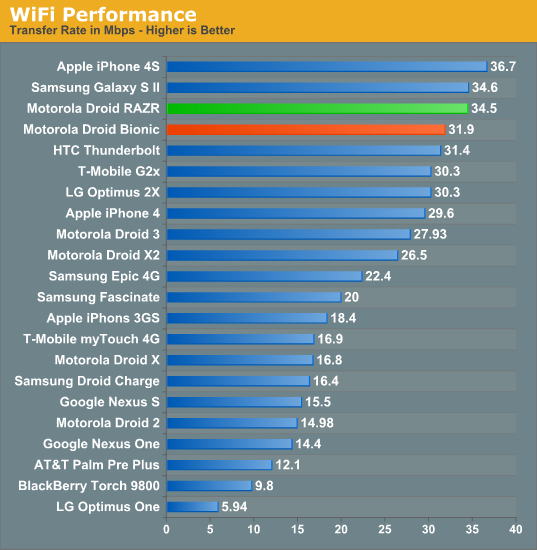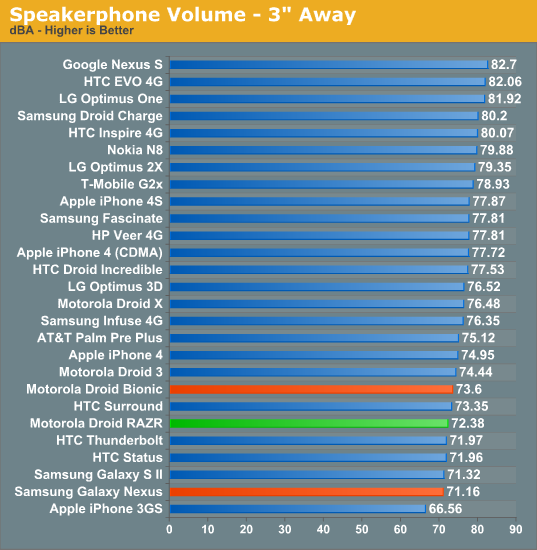Motorola Droid RAZR Review - A Better Clad Bionic
by Brian Klug on December 16, 2011 2:01 AM EST- Posted in
- Smartphones
- Droid
- LTE
- 4G
- Motorola
- Android
- Mobile
- Droid RAZR
- motorola droid RAZR
WiFi, GPS, Audio and Speakerphone
The RAZR uses a TI Wilink 7 series WL1285 combo chip for Bluetooth and WiFi, which is the same situation as the Bionic, unsurprisingly. WiFi is limited to 2.4 GHz and single spatial stream 802.11n, and I saw the RAZR negotiate a 65 Mbps (long guard interval) physical rate with my 20 MHz 802.11n wireless network. I found that range on the RAZR is totally on par with other smartphones I’ve used. Though the visualization at the top seems to be rather conservative with showing bars, if you go view the actual RSSI for WiFi (inside ##4636## and Wireless Information) you’ll see things are just fine. Bluetooth is 4.0 LE + EDR which is the latest bleeding edge.

Throughput on WiFi is pretty decent and just a tad faster than the Bionic. It’s possible the subtle software differences between the two account for this difference in throughput.
WiFi Hotspot
I had some issues with the RAZR’s WiFi hotspot that I didn’t encounter with the Bionic. Specifically, when using the hotspot with WPA2 enabled, clients would only be able to attach occasionally for a short period, or not at all. This initially posed lots of frustration when trying to do our WiFi hotspot battery life test, however disabling encryption entirely and running a public AP resulted in no instability.
You still can attach a maximum of 5 clients if you pay the extra fare to Verizon to enable tethering (which the device does check to see is provisioned), and on the whole this works well, just only with security set to open in my experience.
GPS
To the best of my knowledge, the RAZR is using the GPS system onboard MDM6600 and not from the TI Wilink 7 series combo chip. It’s a bit hard to nail down for sure, but I was able to confirm on the Bionic and it seems reasonable that the same applies here.
Like we’re used to seeing from that system, GPS locks are super fast even indoors and don’t pause or stutter at all. I didn’t have any issues with GPS and used the RAZR a few times with Google navigation without any hitch.
Audio + Speakerphone
First up in the audio department is speakerphone loudness, which we’ve been measuring for a while now using a USB sound level data logger while placing a test call to the local ASOS. The RAZR is on the quiet side which isn’t incredibly surprising considering the placement and constraints on the size of its acoustic chamber.

The other part of audio is of course call quality, and the RAZR isn’t different at all subjectively from the other Motorola phones on Verizon I’ve reviewed recently. As a reminder all calls go over 1x voice, and by default almost every device uses the EVRC coder, though you can change this to 13k in the programming menu and perceive a slight change in call quality. Noise cancellation features likewise remain the same, again courtesy of the three microphones onboard the RAZR.
The last important audio quality metric is what the device sounds like when playing back music. The Bionic used an ST-E 3.1 CPAC combo power management IC and audio codec, and the RAZR uses an ST-E 3.2 CPCAP. I’m embarrassed to admit it, but I only recently discovered how to change (read: disable) the DSP that Motorola has enabled on the RAZR by default (and ostensibly many other of their devices that have crossed my desk). Because I use Google Music, I rarely venture into the first party Music application, and it’s inside here that the settings lurk for DSP, which are by default enabled.
The background whine that I complained about on the Bionic is reduced but still faintly perceptible with sensitive IEMs on the RAZR. Though it is still present, it’s no longer as fatiguing and irritating as it was on the Bionic. I’m not sure whether that’s more a function of ST-E’s 3.2 (as opposed to 3.1) or something else, but it’s much better.
If you’re interested, I also ran a run of RMAA using an ASUS Xonar Xense sound card and line-in on the RAZR, Nexus S with VoodooSound, and a GSM Galaxy Nexus for comparison. The RAZR with all of the equalizer and DSP settings turned off actually isn’t bad at all, and though I’m not an expert at reading RMAA’s tea leaves, it has good noise figures and frequency response, and though noise takes off at the lower frequencies as our own Chris H. pointed out this less than ideal behavior is only 7% of the spectrum.










76 Comments
View All Comments
JonnyDough - Saturday, December 17, 2011 - link
I should probably mention too that when I got my phone (through Verizon) that I had mobile hotspot, it was one of the reasons I got the phone. Of course, a month later they had made it pay-to-use and blocked me from it with an update. Its kind of like the whole ISP industry putting caps on it because they quote "can't afford" to not do it. Laugh. ArsTechnica had a whole article on that. Its a really good read.loribeth - Tuesday, December 27, 2011 - link
Don't worry, the hot spot connection is a known Razor issue, or at least that is what I have read doing a Google search. I just dropped my hot spot, today. I also got a refund of al charges since my purchase. It will connect, but will immediately disconnect.Shinobi_III - Saturday, December 17, 2011 - link
The razr screen might look bad under a microscope, but compared with the SGS2, the colours are so much better, and no banding at all.The SGS2 with it's supposedly better layout, looks like sh*t next to a razr in the real world displaying photos or even most games that happen to have a color fade.
anandtech pirate - Sunday, December 18, 2011 - link
It’s a bit odd to see the Epic Touch getting better battery life with Wimax than with 3G. Could this be related to a bad Sprint signal at your test location? Sprint 3G data speeds have been terrible in many locations for the past 6 months.victorjr - Sunday, December 18, 2011 - link
This is what should be called Review! "Reviews" done by other sites are a joke. We can decide with much more success. We can read facts and not only biased opinions. Anandtech is the place I have been for years. This will continue. Cant wait to the Galaxy Nexus review.iSayuSay - Sunday, December 18, 2011 - link
I don't want to start another flame because I actually feel this Razr is a damn fine phone (apart from it's not bundled with ICS yet), but truly .. Apple just did it again.Some hi-end Android now start to use a user un-effin-replacable battery in pursue of thinness and the ability of using hi grade material..
Adobe start to drop future support on Mobile Flash plugin.
Some Android now bundled with software or apps which basically iTunes wannabe with all syncing, copying, and not-so-free device managing, something most people bash on iPod and iPhones?
And I'm sure more and more Android handset going to adapt microSIM on their phone. Just like this phone.
Long story short, somehow .. smartphone trend start to follow something that most people hate .. the iPhone
lexluthermiester - Sunday, December 18, 2011 - link
Had to deal with two iPhones with batteries that stopped holding a charge and a few friends have had to deal with similar problems with their iPads. Sealing the battery inside gives the manufacturer an opportunity cut corners in the battery department. Totally unacceptable.doobydoo - Tuesday, January 17, 2012 - link
Thankfully you're in a tiny minority. And you can get dodgy batteries whether it's removable or not.georgekn3mp - Monday, December 19, 2011 - link
I have had the HTC ReZound for a month now, and did not like the width and height of the Razr (or the screen compared to true HD 720p on the ReZound) and hope to see a Galaxy nexus review soon even if Anad never publishes one for the ReZound. I researched all 3 before buying the ReZound and found it was best for my needs and wants for a halo phone.Even if the SunSpider and Vellamo tests on GNex beat the ReZound..I am not switching. I love my first smartphone...with a non-Pentile HD 720p display, dual-core at 1.5ghz, a better 8MP camera with f2.2 lens and not as big a bezel. I like the phone dimensions on Rezound better anyway...I can swipe my thumbs all the way across holding it one-handed and can't on GNex.
So the only thing GNex has that ReZound does not is Android 4.0 (and that will happen eventually). So NFC is crippled anyway without the Google Wallet. Heh, all that waiting for a GNex which is already sporting outdated hardware....I bet both the Razr and ReZound beat it when they get Ice Cream Sandwich...just have to wait long enough.
Rowlf - Monday, December 19, 2011 - link
I just came back from the verizon store in an attempt to escape apple hell. I so desperately wanted the RAZR or galaxy nexus to be a replacement for my old iphone. The razr and nexus seemed to be choking on this review or anywhere on anandtech. Scrolling was not smooth and the nexus even crashed once. I tried the newest iphone just for kicks and it had no problems. Was it the demo floor model?Also the nexus seemed to be half as bright as my old phone. Yes I made sure brightness was as maximum and auto brightness was off. Was it the demo model?
Do I need to go to a different verizon store? Is that as good as it gets at this time and I should be looking or waiting for something else?